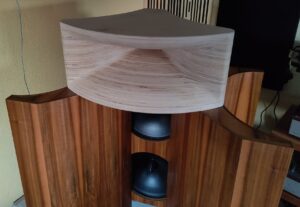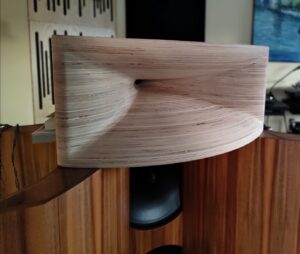Recently, I was involved in a private discussion with a guy who introduced himself as expert for home cinema setups. The topic was about a horn that could be used for a really large home cinema setup. Not what many would imagine immediately like a small room for 2-3 people. No, truly large for 10 or more people and the listening rows / seats have a third dimension in the vertical direction the more far away they are from the source. For such a setup, the horn should have very good directivity control. The person tirelessly promoted the TAD TH4003 as the ultimate solution for such setups. At that time I only knew the TH4003 horn from some pictures. But over the last years I have developed an eye for whether a horn profile meets certain requirements or not. That’s why I expressed my biggest concerns about the vertical pattern control of the TH4003. However, since I had no mesh file or STEP file of the TH4003 available at the time, no final assessment could be made. The discussion then more or less fizzled out. Some months later, a STEP file for TH4003. A few months later, a STEP file literally “fell off the back of a pssing truck” ;-), which gave me the opportunity to examine the horn more closely. I also remembered one of my first William Neile waveguides and the experiments with gentle diffraction slots and realized that I actually already had something much better in the drawer.
Tag Archives: William Neile
DrBA Test Bench: WN300ALO (William Neile Acoustic Loading Optimized fc 300Hz Horn)
In this article I would like to share some measurement results for my new WN300ALO plywood horn. Based on the PLA prototype described here
https://sphericalhorns.net/2022/09/20/acoustic-loading-optimized-william-neile-horns-part-2/
some initial measurements were already done and a preliminary passive crossover network was designed for use in my existing speaker system. This way it was possible to immediately have a listening session when the horns arrived at my home. The measurement results for the PLA horn have not been published because of my concerns about using PLA for such a large horn mainly because of inherent self resonances. And indeed some pronounced and distinct resonances were present in all the measurement data. This has been also verified by spectral analysis when knocking on the horn at different regions. But the results were still good enough for designing a crossover network knowing the problematic resonance frequencies. Maybe it is possible to change the the outer shape of the PLA horn providing better damping. In total contrast to the PLA version the full block plywood version has exceptional good internal damping properties which was one of the main reasons to choose this material and the overall shape of the horn.
Basically it was planned to have a reference setup to compare to so we first listened to the my existing speaker system with 18sound ND3SN@TH4001 fin horn which was my primary choice since a longer time. The TH4001 was a big improvement compared to round Tractrix or any CD horn I tested in my system except for some missing depth of the 3D soundstage. After some songs with the TH4001 in place we mounted the WN300ALO and also changed the readily prepared HF part for the crossover network. What happened with the sound reproduction by switching to the new WN300ALO horn surpassed my highest expectations.
The first Making of a William Neile ALO SE Horn
Some time ago I presented the first article about my development of the ALO William Neile horn type and the underlying construction method. Although, most of my previous worksheets use a super ellipse for each 3D layer / spline along the horn axis. To have an alternative option for William Neile horns I have implemented the the necessary math together with evenly distributed Neile parabolas used in this context to build up the horizontal construction wave front. All William Neile (WN) horns based on the super ellipse algorithm will get the extension “SE” in their name.
By varying the Lamé exponent of the super ellipse formula many different shapes from elliptical to almost rectangular are possible. At throat everything always starts with a Lamé exponent of 2 which indicates an ideal ellipse. Of course, if major and minor axis of the ellipse are equal there will results a perfect circle at throat. If major and minor axis differ an ellipse will result. Generally, the major axis is the horizontal plane because it is intended to radiate more broad compared to the vertical plane (minor axis). For higher Lamé exponents of the super ellipse formula the resulting shape will be an almost rectangular spline but a transition function is needed to provide a smooth transition from exponent 2 to higher values along the horn axis. A very similar procedure was already used for my spherical wave horn (SWH) and JMLC worksheets.
This article is about the first making of such a horn by DonVK who much preferred the native elliptical shape and asked for my assistance to optimize a horn for his setup. Finally, we ended by with two horn of different cut-off. This article describes the making of the first smaller version.


